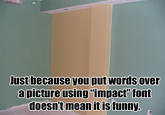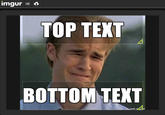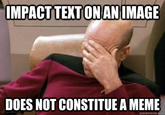Impact
About
Impact is a typeface designed by Geoffrey Lee in 1965 and popularized through its inclusion as one of the Core fonts for the Web in Microsoft's operating system software Windows 98. Due to its thick strokes, compressed letter-spacing and overall high legibility, Impact initially gained traction on the web as a favored choice of font style for headlines and titles by online publishers, before it became known as most widely used font for captions in image macros.
Origin
The realist sans-serif typeface was designed by Geoffrey Lee and released by the Stephenson Blake foundry in 1965. According to Lee, the objective behind the typeface design was to "to get as much ink on paper as possible in a given size with the maximum possible x-height," leading to its noticeably high x-height and narrow spacing between each letter.


In 1996, Microsoft included Impact as one of the Core fonts for the Web in its operating system Windows 98, which at the time served as the operating system for more than 90% of the PC market, giving the font a significant boost in mass exposure.
Spread
By the beginning of the 2000s, image captioning had become a widespread practice among MS Paint and Photoshop users in online forums. As the early image macro culture began to emerge on sites like Something Awful, the font became increasingly visible as a popular choice of font for captioning images, along with Arial and Comic Sans. According to the founder of Something Awful Richard Kyanka[6]:
"I believe the first time the font face changed to Impact was when somebody posted an image of a very obese black woman wearing a spandex superhero outfit, and the text just said 'DAAAAMN.' After that, everybody seemed to use Impact."
In 2003, Something Awful forum user FancyCat submitted the earliest known instance of the Happy Cat image macro with the caption "I Can Has Cheezburger" written in Impact typeface, which paved the way for Impact to be known as the de facto font for captioning LOLcat images. Soon, many other popular image macro memes and reaction images of the time, such as FAIL and Cool Story Bro, began featuring Impact-stylized captions, followed by Advice Animal memes that exploded on to the scene at the turn of the decade (shown below).






Following the launch of numerous image macro generators during the latter half of the decade, Impact further solidified itself as "the meme font" as most captioning tools adopted it as the default typeface, including Cheezburger, Meme Generator, Quickmeme, 9GAG and Imgur among others, typically stylized in white font color and black border.



Criticism
With the rise of the typeface to prominence within the Internet culture, its improper use in irrelevant contexts also became more frequent, prompting a series of image macros with meta-commentaries on the overuse of the Impact font.



Coverage
On May 10th, 2013, German design and technology blogger Dennis[2] published a tutorial guide to captioning images with the Impact font using the image-editing application Photoshop. In December 2014, The Journal of Visual Culture[4] published a research paper titled "A Brief Introduction to Impact: ‘The Meme Font’" by Kate Brideau and Charles Berret, offering a visual-semiotic analysis of the typeface and its stylistic elements that contributed to its prominent usage in image captioning. On June 25th, 2015, CNN[6] ran an article titled "This font has a big Impact on memes" with first-hand accounts of how Impact became the de facto font for image macros from some of the early key players in meme culture, including Something Awful founder Richard Kyanka and Cheezburger founder Ben Huh. On July 26th, Vox[5] highlighted the memetic stature of the typeface in an article titled "The reason every meme uses that one font."
Search Interest
External References
[2] Diary of Dennis – The Most Commonly Used Meme Font And A Tutorial How To Create A Meme With Photoshop
[3] Boing Boing – Why impact Is the Meme Font
[4] A Brief Introduction to Impact – The Meme Font
[5] Vox – The reason every meme uses that one font
[6] CNN – This font has a big Impact on memes
[7] Wikipedia – Core fonts for the Web













Top Comments
Patrick Star 3D Real
Jul 28, 2015 at 03:34PM EDT in reply to
Emperor Palpitoad
Jul 28, 2015 at 03:37PM EDT